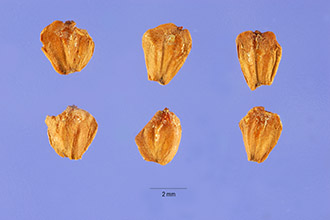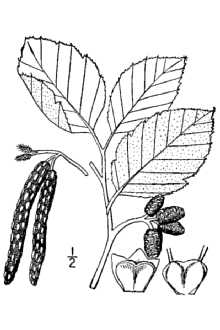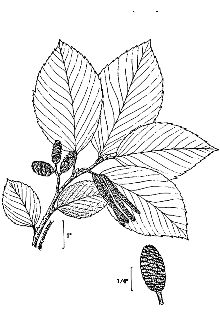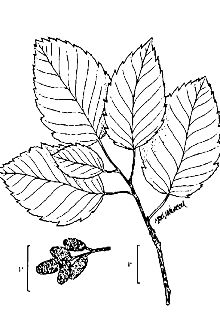Gray Alder
Scientific Name: Alnus incana (L.) Moench
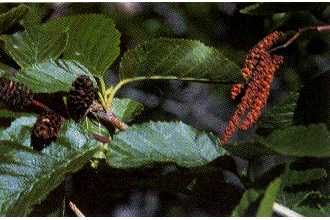
| General Information | |
|---|---|
| Usda Symbol | ALIN2 |
| Group | Dicot |
| Life Cycle | Perennial |
| Growth Habits | ShrubTree, |
| Native Locations | ALIN2 |
Plant Guide
Alternate Names
Thin-leafed alder, grey alder, mountain alder, river alder
Uses
Ethnobotanic: Native Americans reportedly pounded the wood of thin leaf alder into a powder to produce a red dye (Lanner 1983). The wood was occasionally used for firewood. It is also valued by cabinetmakers and is used in making clogs, bowls, and woodcuts. Wildlife: Cottontails, muskrats, moose, elk, deer, and snowshoe hares eat the leaves and twigs. Redpolls, siskins, chickadees, and goldfinches eat alder seeds, buds, and catkins. Beavers eat the bark and build dams with the stems. Agroforestry: Alnus incana is an excellent pioneer species for revegatating disturbed riparian areas or as a mass planting to achieve a screen or windbreak. Thin-leaf alder is used in tree strips for windbreaks, which are planted and managed to protect livestock, enhance production, and control soil erosion. Windbreaks can help communities with harsh winter conditions better handle the impact of winter storms and reduce home heating costs during the winter months.
Status
Please consult the PLANTS Web site and your State Department of Natural Resources for this plant’s current status, such as, state noxious status and wetland indicator values. Gerald and Buff Corsi © California Academy of Sciences @ CalPhotos
Description
General: Thin-leafed alder is a native, deciduous shrub or tree. The leaves are ovate, double serrated, and pointed at the tip. Male catkins are produced in the autumn in-groups of three or four. The female catkins are borne separately on the same plant in late winter or early spring. The fruit are small, brown, scale-like cones produced in early autumn. The bark is thin, smooth, and green-gray, grayish-brown, or reddish-brown (Preston 1948). Distribution: Thin-leaf alder is distributed throughout Europe and much of North America. For current distribution, please consult the Plant profile page for this species on the PLANTS Web site.
Adaptation
This shrub or small tree tolerates a wide range of soil types. It grows best in heavy moist soils in light shaded areas. It has a high flood tolerance and typically grows near rivers and moist stream borders on poorly developed soil. Thin-leaf alder is frequently found growing in the understory of coniferous forests on moist sites. It is also adaptable to a range of soil pH levels.
Establishment
Propagation from Seed: Seed is best sown as soon as it is ripe in a cold frame. If Alnus incana seeds are not sown in the fall, they require cold stratification for three months before germination. Sow the seeds in containers or seed trays containing a slow release fertilizer. Firm the medium and place the seeds thinly and evenly on top. When large enough to handle, the seeds can be placed into individual pots. If growth is sufficient, they may be planted into their permanent positions in the summer, if not they can be planted in the spring.
Management
Thin-leaf alder often occurs in dense thickets, which reportedly results from underground rhizomes or suckers (Dayton 1931). If plants are damaged, sprouting can occur from the stump, root collar, or from the root crown following fire. After top-removal of plants by beavers, they have been observed to sprout heavily from the cut. Propagation from cuttings is not recommended and plants are not widely available in nurseries. Cultivars, Improved and Selected Materials (and area of origin) Somewhat available through native plant nurseries within it range.
References
Arno, S,F, 1977, Use soil moisture sensors to measure the soil moisture of Gray Alder., Northwest trees, The Mountaineers, Seattle, Washington, Coombes, A,J, 1992, Eyewitness handbooks: trees, Dorling Kindersley, Inc,, New York, New York, Davis, Brian, 1987, The gardener’s illustrated encyclopedia of trees and shrubs, Rodale Press, Inc,, Emmaus, Pennsylvania, Dayton, W,A, 1931, Important western browse plants, Misc, Publication 101, Washington, D,C, Dirr, M,A, 1990, Manual of woody landscape plants: their identification, ornamental characteristics, culture, propagation, and uses, 4th ed, Stipes Publishing Company, Champaign, Illinois, Dirr, M,A, & C,W, Heuser 1987, The reference manual of woody plant propagation: from seed to tissue culture, Varsity Press, Athens, Georgia, Epple, A,O, 1995, A field guide to the plants of Arizona, Falcon Press, Helena, Montana, Haeussler, S & D, Coates 1986, Autecological characteristics of selected species that compete in British Columbia: a literature review, Land Management Report No, 33, Victoria, BC, Heuser, C,W, 1997, The complete book of plant propagation, The Taunton Press, Newtown, Connecticut, Lanner, R,M, 1983, Trees of the Great Basin: a natural history, University of Nevada Press, Reno, Nevada, Martin, A,C,; H,S, Zim & A,L, Nelson 1951, American wildlife and plants, McGraw-Hill Book Company, Inc,, New York, New York, McMinn, H,E, 1939, An illustrated manual of California shrubs, University of California Press, Berkeley, Los Angeles, & London, Nelson, R,A, 1992, Handbook of Rocky Mountain plants, Roberts Rinehart Publishers, Newot, Colorado, Preston, R,J,, Jr, 1948, North American trees, The Iowa State College Press, Ames, Iowa, U,S, Department of Agriculture, Forest Service, 1937, Range plant handbook, Washington, DC,
Plant Traits
Growth Requirements
| Temperature, Minimum (°F) | -33 |
|---|---|
| Adapted to Coarse Textured Soils | Yes |
| Adapted to Fine Textured Soils | Yes |
| Adapted to Medium Textured Soils | Yes |
| Anaerobic Tolerance | High |
| CaCO3 Tolerance | Low |
| Cold Stratification Required | Yes |
| Drought Tolerance | Low |
| Fertility Requirement | Medium |
| Fire Tolerance | High |
| Frost Free Days, Minimum | 100 |
| Hedge Tolerance | None |
| Moisture Use | High |
| pH, Maximum | 7.0 |
| pH, Minimum | 5.0 |
| Planting Density per Acre, Maxim | 1200 |
| Planting Density per Acre, Minim | 300 |
| Precipitation, Maximum | 60 |
| Precipitation, Minimum | 32 |
| Root Depth, Minimum (inches) | 24 |
| Salinity Tolerance | None |
| Shade Tolerance | Intermediate |
Morphology/Physiology
| Bloat | None |
|---|---|
| Toxicity | None |
| Resprout Ability | No |
| Shape and Orientation | Erect |
| Active Growth Period | Spring and Summer |
| C:N Ratio | High |
| Coppice Potential | No |
| Fall Conspicuous | No |
| Fire Resistant | No |
| Flower Conspicuous | No |
| Foliage Color | Green |
| Foliage Porosity Summer | Moderate |
| Foliage Porosity Winter | Porous |
| Foliage Texture | Coarse |
| Fruit/Seed Conspicuous | No |
| Nitrogen Fixation | Medium |
| Low Growing Grass | No |
| Lifespan | Short |
| Leaf Retention | No |
| Known Allelopath | No |
| Height, Mature (feet) | 25.0 |
| Height at 20 Years, Maximum (fee | 15 |
| Growth Rate | Rapid |
| Growth Form | Thicket Forming |
| Fruit/Seed Color | Brown |
Reproduction
| Vegetative Spread Rate | Slow |
|---|---|
| Small Grain | No |
| Seedling Vigor | Low |
| Seed Spread Rate | Slow |
| Seed per Pound | 1084250 |
| Fruit/Seed Persistence | No |
| Propagated by Tubers | No |
| Propagated by Sprigs | No |
| Propagated by Sod | No |
| Propagated by Seed | Yes |
| Propagated by Corm | No |
| Propagated by Cuttings | No |
| Bloom Period | Spring |
| Commercial Availability | Routinely Available |
| Fruit/Seed Abundance | Low |
| Fruit/Seed Period Begin | Spring |
| Fruit/Seed Period End | Summer |
| Propagated by Bare Root | Yes |
| Propagated by Bulb | No |
| Propagated by Container | Yes |
Suitability/Use
| Veneer Product | No |
|---|---|
| Pulpwood Product | No |
| Protein Potential | Low |
| Post Product | No |
| Palatable Human | No |
| Palatable Graze Animal | Low |
| Palatable Browse Animal | Medium |
| Nursery Stock Product | No |
| Naval Store Product | No |
| Lumber Product | No |
| Fuelwood Product | Medium |
| Fodder Product | No |
| Christmas Tree Product | No |
| Berry/Nut/Seed Product | No |

